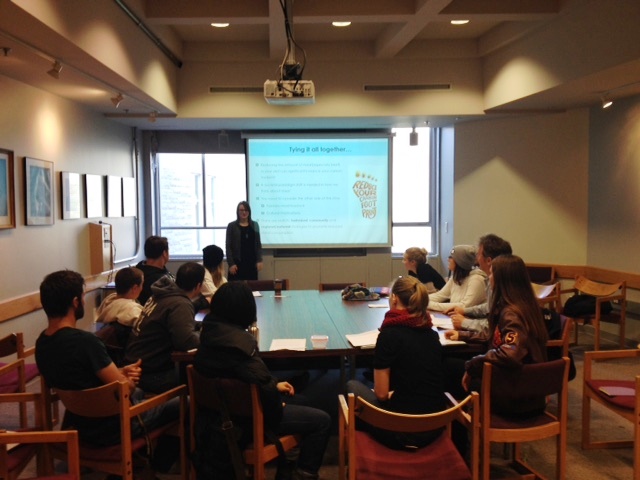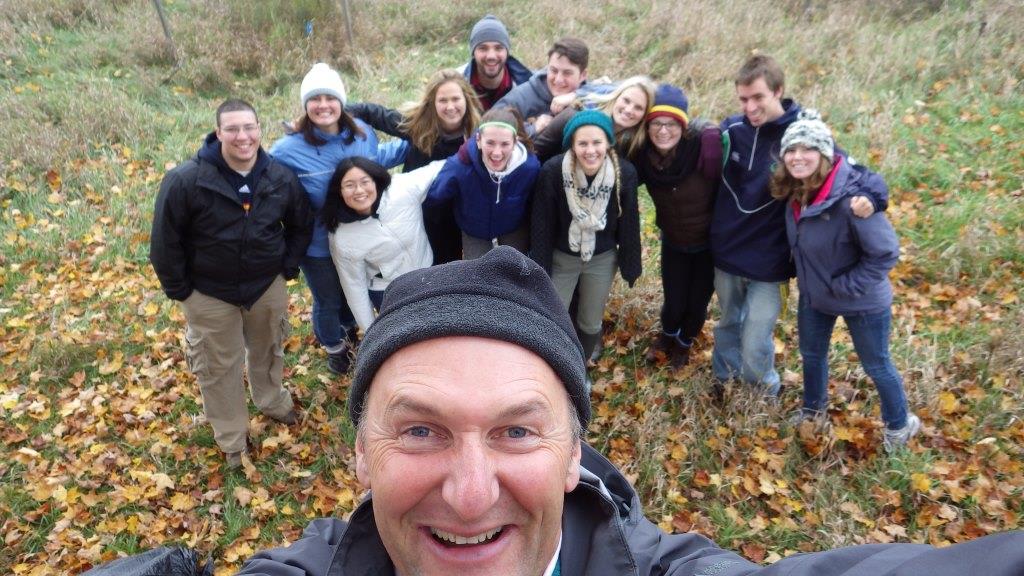The ecosystem approach to ecology treats organisms and the physical aspects of their environment as components of a single integrated system. Terrestrial ecosystem functioning is governed by interactions amongst animals, plants, and soil organisms, as well as exchanges of energy and resources with the atmosphere, soils, rocks, and aquatic environments. This advanced undergraduate level ecology course is focused on plant-soil interactions as being a fundamental determinant of the structure and functioning of terrestrial ecosystems around the world. As a group, we will attempt to synthesize recent advances arising from the ecosystem approach with established ecological theory to describe and explain ecosystem-level patterns and processes in the terrestrial environment. Since human activities are now having increasingly pervasive and dominant effects on natural ecosystems, the course will include an examination of global change issues in the context of landscape-level dynamics in space and time, and whole Earth biogeochemistry. In that context, the course content for 2014/15 in particular will be centered around the following thematic question: What are the problems associated with current farm management practices in agroecosystems, and how can they be realistically and sustainably addressed?
Learning outcomes:
By the end of this course, the student should be able to:
- Explain and evaluate the major concepts underlying terrestrial ecosystem ecology
- Describe and contrast the major processes and features that distinguish local terrestrial ecosystem-types
- Present a synthetic, logical and individualistic seminar on a fundamental issue in terrestrial ecosystem ecology
- Develop, conduct, analyse, and write a lab/field research study that addresses a student-inspired question in terrestrial ecosystem ecology.
Professor: Paul Grogan
Lecture times: Tuesdays 08.30-10.00; Fridays 10.00-11.30
Lab/field trip times: Mostly alternate Mondays: 11.30-14.30; Overnight weekend field course on October 18-19
Lab Instructor: Nishka Wright
Location: Room 3110, (Labs 3311) Biosciences building
Assessment:
5% Field trip presentation
10% Participation in discussions
10% Seminar questions
25% Seminar
25% Research report
25% Final exam
Required textbook: Principles of Terrestrial Ecosystem Ecology. 2011. 2nd edition. Chapin, F.S. III, Matson, P.A. and Vitousek, P. Springer.
Schedule (to be updated throughout the course):
Lecture/Seminar sessions are 80 minutes; Labs up to 3 hours
| Week | Day and time | Convenor | Topic | Reading |
|---|---|---|---|---|
| 08 Sept | Monday 11.30 - LAB | Nishka | Field trip to Bellevue House farm garden | |
| Tuesday, 08.30 | Paul | Introduction: The Ecosystem Concept | Chapin et al, Chapter 1: 1-12,17-22 | |
| Friday, 10.00 | Paul | The Climate System | Chapin et al, Chapter 2: 23-26, 38-41, 50-61 | |
| 15 Sept | Monday 11.30 - LAB | Nishka | Politics- How it can shape science | |
| Tuesday, 08.30 | Paul | Soil Development | Chapin et al, Chapter 1: 13-17; Chapter 3: 63-69 | |
| Friday, 10.00 | Paul | Soil Development continued, and field trip to Miller Hall Geological Museum | ||
| 22 Sept | Monday 11.30 - LAB | Nishka/Paul | Field trip to "The Salt of the Earth" local farm | |
| Tuesday, 08.30 | Paul | Soil Transformations, and Physical Properties | Chapin et al, Chapter 3: 73-78, 82-85 | |
| Friday, 10.00 | Paul | Soil Chemical Properties | Chapin et al, Ch. 3: 86-89; Ch. 7: 204-206; Ch. 9: 287-290; 293-296. | |
| 29 Sept | Monday 11.30 - LAB | Nishka | Proposal development; Lab tour; Guest lecture by Casper Christensen | |
| Tuesday, 08.30 | Paul | The Biology of Soils I | Chapin et al, Chapter 7: 183-194; 243-244; Chapter 9: 271-280 (overview) | |
| Friday, 10.00 | Paul | The Biology of Soils II | Chapin et al, Chapter 7: 183-194; Chapter 11: 321-324; 334-335. | |
| 6 Oct | Monday 11.30 - LAB | Nishka | Proposal development | |
| Tuesday, 08.30 | Paul | Decomposition, and Plant-Soil interactions | Chapin et al, Chapter 7: 194-204; Chapter 8: 229-233, 238-241, 253-255 | |
| Friday, 10.00 | No class | |||
| 13 Oct | THANKSGIVING | |||
| Tuesday, 08.30 | Caleb Axelrod | In what contexts is agroforestry a viable option for improving sustainable agriculture? | Wotherspoon, A. et al. 2014. Carbon sequestration potential of five tree species in a 25-year old temperate tree-based intercropping system in southern Ontario, Canada. Agroforestry Systems (88):631-643. | |
| Friday, 10.00 | Russell Stairs | What are likely to be the most effective options to sustain our current agricultural practices once fossil fuels run out? | Hunt C.L. et al, 2013. NOx emissions and performance of a compact diesel tractor fueled with emulsified and non-emulsified biodiesel. Journal of Agric. Systems, Tech., and Management (24):12-22. | |
| 18 Oct | Overnight field trip | Field visits to Kaiser Lake no-till conventional farm, and to two ecosystem-level manipulative experiments in old field meadow grassland | ||
| 19 Oct | Overnight field trip | Field visit to Ravensfield Biodynamics farm | ||
| 20 Oct | Tuesday, 08.30 | Fiona Emdin |
Why is livestock hormone runoff a serious issue in agriculture, and what is the best strategy to address it? |
Lucas, S, and Jones, D.L. 2006. Biodegradation of estrone and 17beta-estradiol in grassland soils amended with animal wastes. Soil Biology and Biochemistry (38):2803-2815. |
| Friday, 10.00 | John Serafini | On balance, will climate change have a net positive or negative effect on Ontario’s wine production? | Parra et al. 2010. Effects of climate change scenarios on Tempranillo grapevine (Vitis vinifera L.) ripening: response to a combination of elevated CO2 and temperature, and moderate drought. Plant and Soil 337:179–191. |
|
| 27 Oct. | Monday 11.30 - LAB | Nishka | Student projects -collection/processing of samples | |
| Tuesday, 08.30 | Victoria Donovan | How are the impacts of climate change and the desire for sustainable agriculture influencing one another? Which of these two factors has the greater economic force? | Nelson, G.C. et al. 2014. Agriculture and climate change in global scenarios: why don’t the models agree. Agricultural Economics 45: 85–101. | |
| Friday, 10.00 | Jin-Zhi (Gigi) Pao |
Is a local diet really a good alternative to reach environmental sustainability, and how can it be balanced with social and economic concerns? |
Giambolini et al. 2011. Testing the local reality: does the Willamette Valley growing region produce enough to meet the needs of the local population? A comparison of agriculture production and recommended dietary requirements. Agriculture and Human Values 28:247-262 | |
| 3 Nov. | Tuesday, 08.30 | Benia Nowak |
How can the socio-economic constraints that deter small-scale permaculture and biodynamic agriculture adoption be overcome? |
Reeve J.R. et al. 2011. Sustainable agriculture: A case study of a small Lopez Island farm. Agricultural Systems 104:572–579 |
| Friday, 10.00 | Holly Downey |
How can vertical agriculture be developed to make economic and environmental sense as part of the solution to sustainable food production? |
Astee, L and Kishnani, N. 2010. Building Integrated Agriculture - Utilising rooftops for sustainable food crop cultivation in Singapore. Journal of Green Building 5(2): 105-113. Cox, S. and Van Tassel, D. 2010. Vertical farming doesn't stack up. Synthesis/Regeneration 52: 4-7. |
|
| 10 Nov. | Monday 11.30 - LAB | Nishka | Statistical analyses of project data | |
| Tuesday, 08.30 | Keira Mckee | Should the government provide subsidies to encourage farmers to switch to no-till farming from conventional farming? | Epplin, F et al. 2005. Coste of conventional tillage and no-till continuous wheat production for four farm sizes. Journal of American Society of Farm Managers and Rural Appraisers 69-76. | |
| Friday, 10.00 | Jessie Luedi | What strategies would be most effective in promoting reduced meat consumption to mitigate climate change? | Scarborough, P.et al, 2014. Dietary greenhouse gas emissions of meat-eaters, fish-eaters, vegetarians, and vegans in the U.K. Climatic Change 125: 179-192. | |
| 17 Nov. | Tuesday, 08.30 | Jordan Constant | Are GM crops a viable option for the progression of agriculture and how can the barriers (social or otherwise) involved be reasonably addressed? | Seralini G-E., et al, 2012. Long term toxicity of a Roundup herbicide and a Roundup-tolerant genetically modified maize. Food and Chemical Toxicology 50: 4221–4231. |
| Friday, 10.00 | Paul | Sustaining socio-ecological systems | Chapin et al, Chapter 15 | |
| 24 Nov. | Monday 11.30 - LAB | Nishka | Student project presentations | |
| Tuesday, 08.30 | No class | |||
| Friday, 10.00 | Paul | Synthesis |


Last Updated:27 Nov 2014
To see materials from previous iterations of this course, use the drop-down menu under the 'Teaching' tab at the top of this page
Journals
Resources
Recommended Journal Papers
Foley, J et al. (2011) Solutions for a cultivated planet. Nature. 478: 337–342
Loos et al (2014). Putting meaning back into “sustainable intensification”. Frontiers in Ecology and Environment 12(6):356-361.
Maeder, P. et al. (2002). Soil Fertility and Biodiversity in Organic Farming. Science 296, 1694 (2002)
Pimental, D. et al. (2005) Environmental, Energetic, and Economic Comparisons of Organic and Conventional Farming Systems. Bioscience 55(7):573-582.
Tilman, D. et al (2002). Agricultural sustainability and intensive production practices. Nature 418:671-677.
Trewevas, A. (2001). Urban myths of organic farming. Nature 410:409-410.